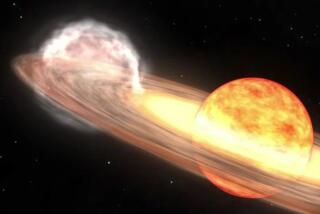Energy Burst From Neutron Star Recorded
- Share via
GREENBELT, Md. — A massive burst of energy exploded from a far-off neutron star in December, the brightest flash of light ever detected beyond the solar system, scientists said Friday.
The Dec. 27 flare was by far the largest of three such giant outbursts of gamma rays detected in the last 35 years from neutron stars, the densely packed and supercharged remnants of collapsed stars.
“This is a once-in-a-lifetime event,” said David Palmer, a scientist at Los Alamos National Laboratory in New Mexico and lead author of a paper on the flare.
The burst, packing more energy than the sun emits every 150,000 years, was not visible to humans, and the gamma rays were blocked by the Earth’s atmosphere. But scientists said some operators of low-frequency transmitters were able to detect the blast.
The National Aeronautics and Space Administration’s new satellite observatory is among the instruments that detected the flare.
The satellite, launched in November to probe the workings of black holes, is controlled by scientists at the Goddard Space Flight Center in Greenbelt. Its name is Swift because it is designed to detect gamma ray outbursts and quickly pivot to record them. It also recorded the afterglow of the blast.
“Swift, within a mere month of its launch, was able to participate in an amazing discovery,” said Roger Blandford, a physicist at Stanford University.
Neutron stars are formed when massive stars run out of fuel and collapse, creating dense, fast-spinning and highly magnetic solar corpses that are only about 15 miles in diameter.
The December burst lasted a tenth of second and came from a neutron star about 50,000 light years from Earth in the constellation Sagittarius. Called SGR 1806-20, it is one of about 12 known magnetars, a neutron star with a magnetic field that is trillions of times stronger than that of Earth.
Scientists believe that the magnetic field of the magnetars can shift like an earthquake, causing it to eject a huge burst of energy. SGR 1806-20 is known as a “soft gamma repeater” because the initial flare is followed by a series of much smaller releases of gamma rays. The December flare was up to a billion times more powerful than typical flares from soft gamma repeaters.






